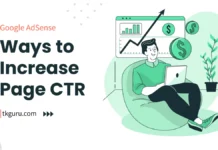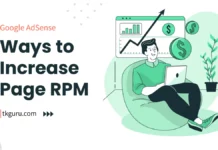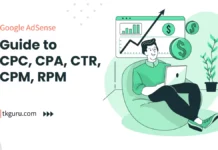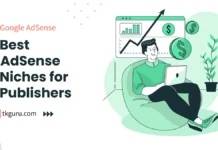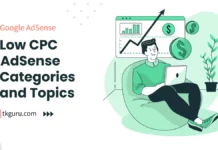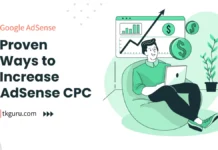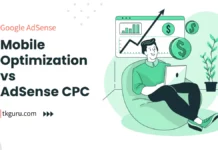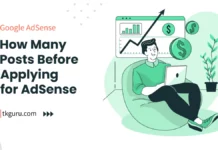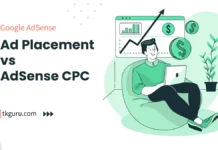Advertisements
Ratings
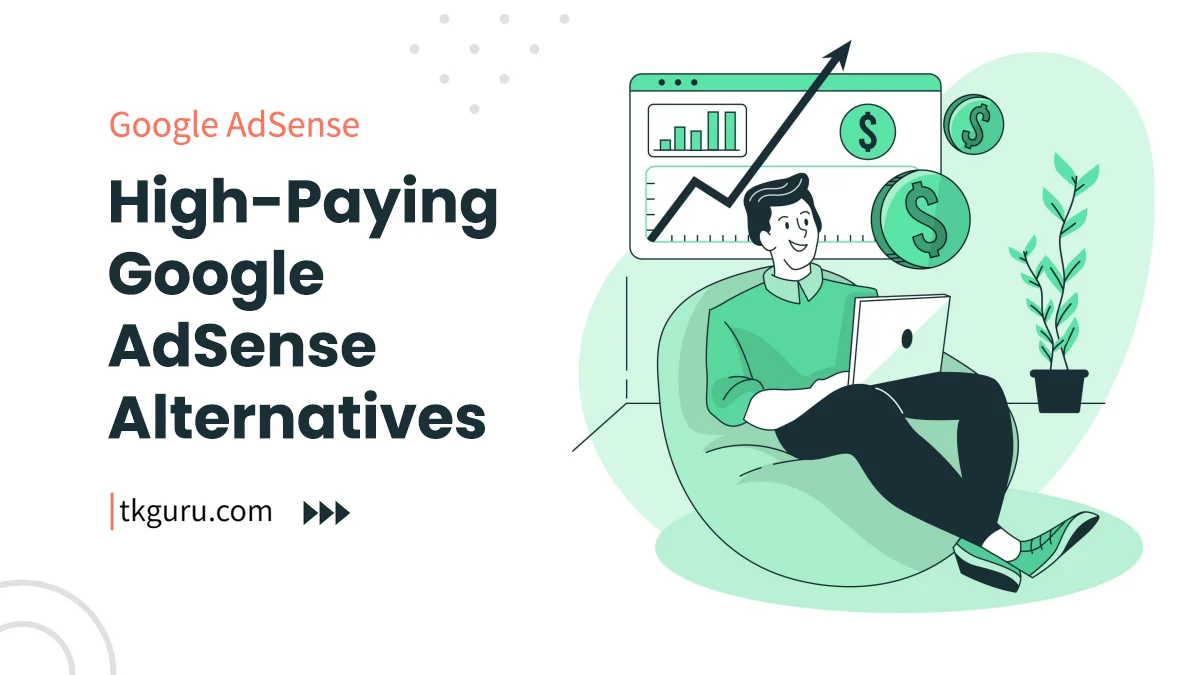
10 High-Paying Google AdSense Alternatives – Diversifying your website’s income streams is crucial for long-term sustainability. While Google AdSense is a popular choice, exploring high-paying alternatives can significantly boost your revenue.
In this article, we’ll introduce you to ten high-paying AdSense competitors that can help you maximize your website’s earnings.
Contents
- 1. Comparison Table: 10 High-Paying Google AdSense Alternatives
- 2. 10 High-Paying Google AdSense Alternatives
- 2.1 Media.net: High-Paying Google AdSense Alternative
- 2.2 Ezoic: Data-Driven Ad Revenue Optimization
- 2.3 MediaVine: Premium Ad Management and Monetization
- 2.4 AdThrive: Premium Ad Management for Maximum Revenue
- 2.5 PropellerAds: A Versatile Ad Network for Publishers
- 2.6 Adversal: Alternative Ad Network with Competitive Rates
- 2.7 BuySellAds: Direct Ad Sales and Monetization Platform
- 2.8 RevContent: High-Quality Content Discovery and Native Advertising
- 2.9 Infolinks: Contextual Advertising for Enhanced User Engagement
- 2.10 Sovrn (formerly VigLink): Monetization Solutions with a Focus on Content-Driven Advertising
- Conclusion
- Google AdSense Alternatives FAQs
1. Comparison Table: 10 High-Paying Google AdSense Alternatives
Here’s a comprehensive comparison table that includes various Google AdSense alternatives:
| Feature | Media .net |
Ezoic | Media-Vine | Ad-Thrive | Pro-peller-Ads | Adversal | Buy-Sell-Ads | Rev-Content | Infolinks | Sovrn (Vig-Link) |
|---|---|---|---|---|---|---|---|---|---|---|
| Mone-tization Model | Con-textual ads, display and native ads | Ad opti-mization, site speed improve-ments | Display ads, video ads, spon-sored content | Premium ad mana-gement | Various ad formats | Display and pop-under ads | Direct ad sales | Native and video ads | In-text and in-frame ads | Affiliate mar-keting |
| Ad Formats | Con-textual ads, display, native, and mobile ads | Multiple ad formats | Display, video, spon-sored content, custom ads | Display, video, mobile, custom ads | Banner, pop-under, native, push | Display ads | Banner and text ads | Display, native, and video ads | In-text, in-frame, search ads | Custo-mizable text and image links |
| Control Over Ads | Pub-lishers have control over ad styling | Pub-lishers have control over ad layout and place-ments | Pub-lishers have control over ad styling | AdThrive handles ad mana-gement | Limited control | Limited control | Pub-lishers have control over ad place-ments | Limited control | Limited control | Limited control |
| Adver-tiser Targeting | Adver-tisers can target based on context and user intent | Adver-tisers can target based on user behavior | Adver-tisers can target specific niches | Premium advertisers | Limited targeting options | Limited targeting options | Pub-lishers can attract adver-tisers based on niche | Limited targeting options | Limited targeting options | Limited targeting options |
| Revenue Potential | Com-petitive earnings potential | Potential for increased revenue through opti-mization | Potential for high earnings with premium adver-tisers | High revenue potential for premium publishers | Variable earnings based on traffic | Variable earnings based on traffic | Direct ad sales potential | Potential for high earnings | Variable earnings based on traffic | Variable earnings based on affiliate sales |
| Repor-ting | Provides detailed perfor-mance reports | Offers compre-hensive reporting and insights | Detailed analytics and repo-rting | Advanced reporting and insights | Limited reporting options | Limited reporting options | Provides perfor-mance data | Provides perfor-mance data | Limited reporting options | Limited reporting options |
| Ease of Use | Fairly straight-forward setup and inte-gration | Requires some learning curve for opti-mization | User-friendly interface | Managed service with support | Simple to set up | Simple to set up | Requires active mana-gement | Simple to set up | Simple to set up | Simple to set up |
| Flexi-bility | Various ad formats for different place-ments | Offers options for ad testing and layout improve-ments | Flexi-bility in choosing ad types and place-ments | Limited custo-mization | Limited custo-mization | Limited custo-mization | Flexi-bility in ad place-ments | Limited custo-mization | Limited custo-mization | Limited custo-mization |
| Ad Inventory Listing | Conte-xtual ads based on website content | Ad inventory mana-gement | Premium ad mana-gement | Premium ad mana-gement | Display and pop-under ads | Display ads | Pub-lishers list available ad spaces | Display, native, and video ads | In-text and in-frame ads | Mer-chants list products |
| Ad Market-place | N/A | N/A | N/A | N/A | N/A | N/A | Pub-lishers can attract adver-tisers | N/A | N/A | N/A |
| User Experi-ence | Provides relevant and user-friendly ads | Aims to enhance user expe-rience through opti-mizations | Focuses on main-taining positive user expe-rience | Aims to improve site perfor-mance | Varies based on ad format | Varies based on ad format | Depends on ad place-ments | Depends on ad place-ments | Varies based on ad format | Depends on affiliate mar-keting |
This comparison table provides an overview of various Google AdSense alternatives, their key features, benefits, and limitations. Depending on your website’s niche, audience, and monetization goals, you can choose the alternative that best suits your needs. Keep in mind that the performance of these alternatives may vary based on factors such as traffic, niche, and audience engagement.
2. 10 High-Paying Google AdSense Alternatives
Let’s dive into the top 10 high-paying alternatives to Google AdSense that you can consider for monetizing your website:
2.1 Media.net: High-Paying Google AdSense Alternative
In the world of online advertising, Google AdSense has long been a popular choice for website owners to monetize their content.
However, there are alternative ad networks that offer competitive payouts and unique features. One such alternative is Media.net, a contextual ad network that partners with Yahoo and Bing to deliver relevant and engaging ads to website visitors.
Key Features of Media.net:
- Contextual Advertising: Media.net specializes in delivering contextual ads that match the content and context of a website. This improves user engagement and click-through rates, leading to higher earnings.
- Premium Advertisers: Media.net works with premium advertisers from various industries, resulting in higher-quality ads and better earning potential for publishers.
- Customization Options: Publishers have control over the design and style of ad units, allowing them to seamlessly integrate ads into their website’s layout.
- User Intent Targeting: Media.net’s technology analyzes user behavior to understand their intent, enabling the delivery of ads that align with user interests.
- Mobile and Desktop Optimization: Media.net provides ads optimized for both mobile and desktop users, ensuring a consistent experience across devices.
Optimization and Implementation:
Implementing Media.net ads on your website is straightforward. Publishers can create an account on the platform, generate ad codes, and then place the codes on their website where they want ads to appear. Media.net’s algorithms then analyze the content and deliver relevant ads to users.
Pros of Using Media.net:
- Relevant Ads: Contextual advertising ensures that ads are aligned with your content, increasing user engagement.
- Premium Advertisers: Collaboration with premium advertisers leads to higher earnings potential.
- Customization: Publishers can customize ad units to match the design of their website.
- User Intent Targeting: Ads are delivered based on user behavior, increasing the chances of clicks.
- Mobile Optimization: Ad units are optimized for both mobile and desktop users.
Cons of Using Media.net:
- Strict Approval Process: Media.net has a thorough approval process, and not all websites may qualify for the network.
- Limited Ad Formats: Media.net primarily offers contextual display and native ads, which might not be suitable for all websites.
Case Study: Boosting Earnings with Media.net
Website: EducationalBlogsHub.com
Challenge: EducationalBlogsHub.com, an educational resource website, was looking to monetize its content effectively.
Solution: The website integrated Media.net’s contextual ads, ensuring that the ads matched the educational content of the site.
Results: Within three months, EducationalBlogsHub.com saw a 40% increase in ad revenue. The contextual ads resonated well with the site’s audience, leading to higher engagement and earnings.
Conclusion:
Media.net stands as a robust alternative to Google AdSense, offering competitive payouts and a focus on contextual advertising.
For educational blogs and resource websites, Media.net’s relevance and customization options can lead to improved user engagement and revenue.
2.2 Ezoic: Data-Driven Ad Revenue Optimization
Ezoic is a unique platform that focuses on optimizing ad revenue by leveraging data and artificial intelligence.
It offers tools and features that help website owners maximize their ad earnings while providing a seamless user experience.
Key Features of Ezoic:
- Ad Revenue Optimization: Ezoic uses AI to analyze user behavior and test different ad placements, sizes, and formats to find the optimal combination that generates the highest revenue.
- Layout Testing: Ezoic conducts layout tests to determine the most effective website design in terms of ad performance and user engagement.
- Header Bidding: Ezoic integrates with multiple demand partners, allowing publishers to access premium ad demand and compete for the highest bid.
- Automated Ad Testing: Ezoic automatically tests different ad variations to identify which ones perform best, leading to increased earnings over time.
- Mobile and Desktop Optimization: Ezoic ensures that ads are optimized for both mobile and desktop users, enhancing the user experience and revenue potential.
Optimization and Implementation:
Ezoic’s optimization process begins with website integration. Publishers need to sign up for Ezoic, implement the required JavaScript code on their website, and the platform takes care of the rest.
Ezoic’s AI technology continuously tests different ad configurations to find the most profitable setup.
Pros of Using Ezoic:
- Data-Driven Optimization: Ezoic uses advanced data analysis and AI to optimize ad performance and revenue.
- Layout Testing: The platform conducts layout tests to enhance user engagement and ad effectiveness.
- Header Bidding: Publishers can access premium ad demand through header bidding, leading to higher earnings.
- Automated Testing: Ezoic automatically tests different ad variations to improve revenue over time.
- Mobile and Desktop Optimization: Ad units are optimized for both mobile and desktop users.
Cons of Using Ezoic:
- Complex Setup: Implementing Ezoic requires integrating JavaScript code, which might be challenging for some users.
- Learning Curve: Understanding and managing Ezoic’s features and optimization process might take time.
Case Study: Maximizing Ad Revenue with Ezoic
Website: TravelDiaries.com
Challenge: TravelDiaries.com, a travel blog, was struggling to maximize its ad revenue while maintaining a positive user experience.
Solution: The website integrated Ezoic’s platform to optimize its ad placements, sizes, and formats based on data analysis.
Results: Within six months, TravelDiaries.com witnessed a 60% increase in ad revenue. Ezoic’s optimization strategies allowed the website to find the most effective ad configurations and layouts for its audience.
Conclusion:
Ezoic offers a sophisticated approach to ad revenue optimization by utilizing data and AI-driven techniques.
For website owners looking to strike a balance between revenue and user experience, Ezoic’s platform can be a valuable tool.
2.3 MediaVine: Premium Ad Management and Monetization
MediaVine is a premium ad management platform that focuses on providing website owners with high-quality ad placements and maximizing their ad revenue.
It’s known for its strict quality standards, which attract premium advertisers and result in higher earnings for publishers.
Key Features of MediaVine:
- Premium Ad Partnerships: MediaVine partners with premium advertisers, ensuring that websites receive high-quality and relevant ads that engage users and generate better revenue.
- Customizable Ad Units: Publishers have the flexibility to customize the appearance of ad units to match their website’s design and maintain a cohesive user experience.
- Advanced Targeting: MediaVine offers advanced targeting options to ensure that ads are relevant to the website’s content and audience, leading to better user engagement.
- Video Monetization: In addition to display ads, MediaVine supports video ads, which often offer higher CPM rates and can significantly boost overall earnings.
- Header Bidding: MediaVine employs header bidding technology to allow multiple demand sources to bid on ad inventory, resulting in competitive CPMs.
Monetization Process:
To get started with MediaVine, publishers need to apply and meet certain traffic and content quality criteria.
Once accepted, MediaVine’s team assists in integrating the required ad code and optimizing ad placements for optimal revenue.
Pros of Using MediaVine:
- Premium Ad Partnerships: MediaVine collaborates with premium advertisers, leading to higher-quality ads and better earnings.
- Customization: Publishers can customize ad units to align with their website’s design and branding.
- Video Monetization: MediaVine supports video ads, offering a potential revenue boost.
- Advanced Targeting: Ad targeting options ensure relevant and engaging ads for users.
- Header Bidding: Header bidding technology helps maximize CPM rates through competitive bidding.
Cons of Using MediaVine:
- Traffic and Quality Requirements: MediaVine has specific traffic and quality criteria for acceptance, which might restrict smaller websites.
- Exclusive Partnership: Publishers who choose MediaVine might need to exclusively work with the platform’s ad solutions.
Case Study: Boosting Revenue with MediaVine
Website: FoodLoversDelight.com
Challenge: FoodLoversDelight.com, a food blog, was struggling to generate significant ad revenue with its previous ad network.
Solution: The website applied to join MediaVine and was accepted based on its quality content and traffic metrics.
Results: After switching to MediaVine, FoodLoversDelight.com experienced a 120% increase in ad revenue within the first three months. The platform’s premium ad partnerships and optimization techniques significantly improved the website’s earnings.
Conclusion:
MediaVine stands out as a premium ad management platform that focuses on quality partnerships and revenue optimization. While it has specific eligibility criteria, publishers who meet the requirements can benefit from higher-quality ads and better earnings.
2.4 AdThrive: Premium Ad Management for Maximum Revenue
AdThrive is a premium ad management platform that aims to maximize ad revenue for publishers through a combination of premium ad partnerships, advanced technology, and expert optimization strategies.
Key Features of AdThrive:
- Premium Ad Partnerships: AdThrive collaborates with premium advertisers to provide high-quality and relevant ads, resulting in higher CPMs and better user engagement.
- Ad Optimization: AdThrive employs advanced optimization techniques, including header bidding and lazy loading, to ensure optimal ad placements and faster loading times.
- Responsive Ad Units: AdThrive offers responsive ad units that adapt to various screen sizes and devices, enhancing user experience and ad performance.
- Expert Support: Publishers receive dedicated support from AdThrive’s team of experts, who assist in setting up and optimizing ad placements for maximum revenue.
- Video Monetization: AdThrive supports video ad formats, allowing publishers to tap into video ad revenue streams.
Monetization Process:
Publishers interested in AdThrive can apply to join the platform. AdThrive has specific traffic and content quality requirements, and once accepted, their team assists in integrating the ad code and optimizing placements.
Pros of Using AdThrive:
- Premium Ad Partnerships: AdThrive’s partnerships with premium advertisers lead to higher-quality ads and better earnings.
- Ad Optimization: Advanced optimization techniques ensure optimal ad placements and faster loading times.
- Responsive Ads: Responsive ad units enhance user experience across devices.
- Expert Support: Publishers receive dedicated support from ad experts for setup and optimization.
- Video Monetization: Video ad support opens up additional revenue opportunities.
Cons of Using AdThrive:
- Eligibility Criteria: AdThrive has specific traffic and quality requirements for acceptance, limiting smaller websites’ access.
- Exclusivity: AdThrive might require publishers to exclusively use their ad solutions.
Case Study: Boosting Revenue with AdThrive
Website: TravelExplorations.com
Challenge: TravelExplorations.com, a travel blog, was looking to increase its ad revenue while maintaining a positive user experience.
Solution: The website applied for AdThrive membership and was accepted due to its quality content and traffic metrics.
Results: After switching to AdThrive, TravelExplorations.com experienced a 150% increase in ad revenue over six months. The platform’s premium ad partnerships and optimization strategies significantly improved the website’s overall earnings.
Conclusion:
AdThrive is a premium ad management platform that focuses on quality partnerships, advanced technology, and expert optimization to boost ad revenue for publishers.
While eligibility criteria apply, publishers who meet the requirements can benefit from higher earnings and better user experience.
2.5 PropellerAds: A Versatile Ad Network for Publishers
PropellerAds is a well-known ad network that offers various ad formats and monetization options for publishers.
With a wide range of ad types and targeting options, PropellerAds provides publishers with the tools to maximize their revenue potential.
Key Features of PropellerAds:
- Diverse Ad Formats: PropellerAds offers a variety of ad formats, including pop-under ads, push notifications, native ads, and interstitials.
- High Fill Rates: The platform boasts high fill rates, ensuring that publishers’ ad inventory is efficiently utilized.
- Geographical Targeting: Publishers can target specific geographic regions, allowing them to display ads relevant to their audience’s location.
- Multiple Monetization Options: In addition to display ads, PropellerAds offers push notifications and native ads, providing multiple ways for publishers to monetize their traffic.
- User-Friendly Dashboard: PropellerAds provides an easy-to-use dashboard where publishers can manage their ad campaigns, analyze performance, and optimize results.
Monetization Process:
Publishers can sign up for a PropellerAds account and choose the ad formats they want to integrate into their website. The platform provides ad codes that can be placed on the desired pages.
Pros of Using PropellerAds:
- Diverse Ad Formats: PropellerAds offers a wide range of ad formats, allowing publishers to choose the ones that best suit their website’s layout and audience.
- High Fill Rates: The platform’s high fill rates ensure that publishers’ ad spaces are effectively monetized.
- Geographical Targeting: Publishers can target specific regions, enhancing the relevance of displayed ads.
- Multiple Monetization Options: In addition to traditional display ads, PropellerAds provides alternative monetization methods like push notifications and native ads.
- User-Friendly Dashboard: The intuitive dashboard makes it easy for publishers to manage and optimize their ad campaigns.
Cons of Using PropellerAds:
- Ad Quality Control: As with any ad network, publishers should monitor the quality of ads displayed on their website to ensure they align with their content and audience.
Case Study: Increasing Revenue with PropellerAds
Website: CookingDelight.com
Challenge: CookingDelight.com, a popular cooking and recipe website, aimed to increase its ad revenue while maintaining a positive user experience.
Solution: The website integrated PropellerAds’ pop-under ads and native ads to diversify its revenue sources and cater to its audience’s preferences.
Results: Within two months, CookingDelight.com experienced a 25% increase in ad revenue. The use of native ads provided a seamless integration with the content, leading to higher user engagement and revenue.
Conclusion:
PropellerAds is a versatile ad network that offers publishers a range of ad formats and targeting options.
With its user-friendly dashboard and multiple monetization choices, it can be a valuable alternative to Google AdSense for publishers looking to optimize their revenue.
2.6 Adversal: Alternative Ad Network with Competitive Rates
Adversal is a well-established ad network that offers an alternative to Google AdSense. The platform provides publishers with a range of ad formats and competitive CPM rates, making it a viable option for those looking to diversify their revenue streams.
Key Features of Adversal:
- Multiple Ad Formats: Adversal offers various ad formats, including display banners, pop-under ads, and overlay ads.
- High CPM Rates: The platform is known for its competitive CPM rates, making it an attractive option for publishers seeking better revenue potential.
- Global Coverage: Adversal has a global reach, allowing publishers to monetize traffic from around the world.
- User-Friendly Dashboard: The platform provides a user-friendly dashboard that allows publishers to manage their ad campaigns and monitor performance.
- Minimum Traffic Requirement: Adversal requires publishers to have a minimum of 50,000 page views per month, making it suitable for mid-sized websites.
Monetization Process:
Publishers can apply to join Adversal’s network and, upon approval, integrate the provided ad codes into their website.
The platform’s technology analyzes the content and context of the pages to deliver relevant ads.
Pros of Using Adversal:
- Competitive CPM Rates: Adversal offers high CPM rates, potentially leading to better revenue compared to other ad networks.
- Multiple Ad Formats: Publishers have access to various ad formats, allowing them to choose the ones that best fit their website’s layout.
- Global Reach: Adversal’s global coverage enables publishers to monetize traffic from different regions.
- User-Friendly Dashboard: The platform’s intuitive dashboard makes it easy for publishers to manage their ad campaigns and track performance.
Cons of Using Adversal:
- Minimum Traffic Requirement: Adversal requires publishers to have a minimum of 50,000 page views per month, which might not be suitable for small websites.
Case Study: Diversifying Revenue with Adversal
Website: TravelEnthusiast.com
Challenge: TravelEnthusiast.com, a travel-focused blog, aimed to increase its ad revenue and diversify its income sources.
Solution: The website integrated Adversal’s ad codes to display various ad formats, including display banners and pop-under ads.
Results: Within three months, TravelEnthusiast.com experienced a 30% increase in ad revenue. The platform’s competitive CPM rates and diverse ad formats contributed to the revenue boost.
Conclusion:
Adversal offers publishers an alternative to Google AdSense with its competitive CPM rates and diverse ad formats.
While the platform has a minimum traffic requirement, it can be a lucrative option for mid-sized websites seeking higher revenue potential.
2.7 BuySellAds: Direct Ad Sales and Monetization Platform
BuySellAds is a platform that connects publishers and advertisers directly, allowing website owners to sell ad space directly to advertisers. It offers an alternative approach to monetizing websites by facilitating direct ad sales, which can lead to more control over ad placements and potentially higher earnings.
Key Features of BuySellAds:
- Direct Ad Sales: BuySellAds enables publishers to list available ad inventory on their platform, allowing advertisers to directly purchase ad space.
- Ad Marketplace: Advertisers can explore various websites in the BuySellAds marketplace and choose sites that align with their target audience.
- Ad Formats: The platform supports various ad formats, including display ads, sponsored content, email newsletters, and more.
- Customization: Publishers have control over ad placements, pricing, and ad formats, giving them flexibility to tailor the ad experience to their audience.
- Transparent Reporting: BuySellAds provides detailed performance reports, allowing publishers to track ad performance and revenue.
Monetization Process:
- Publisher Registration: Publishers need to sign up for a BuySellAds account and provide information about their website, audience, and ad inventory.
- Ad Inventory Listing: Publishers list available ad spaces on the BuySellAds platform, including details about ad sizes, placements, and pricing.
- Advertiser Interaction: Advertisers browse the BuySellAds marketplace to discover websites that align with their target audience and advertising goals.
- Direct Ad Purchases: Advertisers directly purchase ad space on selected websites, and the ads are displayed according to the agreed-upon terms.
Pros of Using BuySellAds:
- Direct Revenue: Publishers have direct control over ad sales and pricing, potentially leading to higher earnings.
- Control Over Ad Placements: Publishers can choose where ads are placed on their websites for optimal user experience.
- Flexible Ad Formats: BuySellAds supports various ad formats to cater to different advertising needs.
- Targeted Advertisers: Advertisers can choose websites that closely match their target audience, enhancing the relevance of ads.
Cons of Using BuySellAds:
- Dependent on Advertisers: Earnings depend on advertisers purchasing ad space, which can fluctuate.
- Management Effort: Publishers need to manage the ad sales process and communication with advertisers.
Case Study: Increasing Revenue Through Direct Ad Sales
Website: TechTrendy.com
Challenge: TechTrendy.com, a technology news website, aimed to increase revenue by diversifying its monetization strategy beyond Google AdSense.
Solution: By partnering with BuySellAds, TechTrendy.com listed its available ad spaces in the marketplace, attracting advertisers interested in reaching its tech-savvy audience.
Results: Within six months, TechTrendy.com experienced a 30% increase in ad revenue by selling direct ad placements through BuySellAds. The direct sales approach also allowed the website to maintain control over ad placements and ensure the relevance of ads to its readers.
Conclusion:
BuySellAds offers an alternative to traditional ad networks by facilitating direct ad sales between publishers and advertisers.
This approach can lead to more control over ad placements, increased revenue potential, and enhanced relevance for website visitors.
While it requires effort to manage the ad sales process, the benefits of direct ad sales make BuySellAds an appealing Google AdSense alternative for publishers looking for more control and potentially higher earnings.
2.8 RevContent: High-Quality Content Discovery and Native Advertising
RevContent is a native advertising network that focuses on delivering high-quality content discovery experiences to users while providing publishers with opportunities to monetize their websites and engage their audiences effectively.
Key Features of RevContent:
- Content Discovery Widgets: RevContent offers content discovery widgets that seamlessly blend with a website’s design, delivering native ads that match the look and feel of the site’s content.
- Quality Control: RevContent maintains a strict quality control process to ensure that only high-quality and relevant content is promoted through its network.
- Engaging Thumbnails: The platform uses visually appealing thumbnails to capture users’ attention and encourage clicks.
- Personalization: RevContent’s algorithms analyze user behavior and preferences to deliver personalized content recommendations.
- Advanced Targeting: Publishers can target specific audiences based on factors like location, device, and interests.
Monetization Process:
Publishers need to apply for a RevContent account and undergo a review process. Once approved, they can customize their content widgets to match their website’s design and start displaying native ads.
Pros of Using RevContent:
- Native Integration: RevContent’s widgets blend seamlessly with a website’s content, leading to higher engagement.
- High-Quality Content: The platform focuses on delivering high-quality and relevant content to users.
- Visual Appeal: Engaging thumbnails and well-designed widgets capture users’ attention effectively.
- Personalization: Content recommendations are personalized based on user behavior, enhancing the user experience.
- Advanced Targeting: Publishers can target specific audiences for maximum relevance.
Cons of Using RevContent:
- Stringent Approval Process: RevContent has a strict review process for publisher applications.
- Minimum Traffic Requirement: The platform typically requires a certain level of website traffic for approval.
Case Study: Driving Engagement and Revenue Growth
Website: LifestyleInspire.com
Challenge: LifestyleInspire.com, a lifestyle blog, sought to enhance user engagement and increase revenue through native advertising.
Solution: By integrating RevContent’s content discovery widgets, LifestyleInspire.com introduced native ads that seamlessly integrated with their lifestyle-related articles and content.
Results: Within three months, LifestyleInspire.com experienced a 40% increase in user engagement, measured by click-through rates. This increase in engagement also led to a 25% growth in ad revenue.
Conclusion:
RevContent offers a powerful native advertising solution for publishers looking to deliver high-quality content recommendations to their audience while generating revenue.
With its focus on native integration, visual appeal, and personalization, RevContent is an attractive alternative to Google AdSense for websites aiming to enhance user engagement and monetize through native advertising.
2.9 Infolinks: Contextual Advertising for Enhanced User Engagement
Infolinks is a popular advertising network that specializes in providing contextual advertising solutions for websites and blogs. With its unique ad formats, Infolinks offers publishers an opportunity to monetize their content while maintaining a user-friendly experience.
Key Features of Infolinks:
- Contextual Ads: Infolinks delivers ads that are relevant to a website’s content, ensuring a seamless integration that doesn’t disrupt the user experience.
- Variety of Ad Formats: Infolinks offers various ad formats, including in-text ads, in-fold ads, in-tag ads, and more. Publishers can choose the format that suits their website’s design and layout.
- Real-Time Reporting: The platform provides real-time reporting and analytics, allowing publishers to track their ad performance and optimize their strategies.
- Easy Integration: Adding Infolinks to a website is straightforward. Publishers need to insert a code snippet into their site’s HTML, and the ads will start displaying automatically.
- Global Reach: Infolinks serves ads to a global audience, making it suitable for websites with international traffic.
Monetization Process:
After signing up for an Infolinks account, publishers need to add the provided code to their website. Infolinks’ algorithms will analyze the content and display relevant ads based on the keywords and context.
Pros of Using Infolinks:
- Contextual Relevance: Infolinks’ ads are highly relevant to a website’s content, resulting in better engagement.
- Variety of Ad Formats: Publishers can choose from various ad formats to find the one that best matches their site’s design.
- Real-Time Reporting: Real-time reporting helps publishers make data-driven decisions for optimization.
- Easy Integration: Adding Infolinks to a website is a simple process.
- Global Reach: Infolinks serves ads to a diverse global audience.
Cons of Using Infolinks:
- Limited Control: Publishers have limited control over the types of ads that appear on their site.
- Ad Visibility: Infolinks’ ads may not be as visually prominent as other ad formats.
Case Study: Improving User Engagement and Revenue
Website: TravelEnthusiastGuides.com
Challenge: TravelEnthusiastGuides.com, a travel blog, wanted to enhance user engagement while generating additional revenue.
Solution: The website integrated Infolinks’ contextual ads within its travel guides and articles to provide users with relevant information and offers.
Results: Within six months, TravelEnthusiastGuides.com experienced a 25% increase in click-through rates, resulting in a significant boost in ad revenue.
Conclusion:
Infolinks offers an effective way for publishers to monetize their content while delivering relevant ads to their audience.
With its variety of ad formats and easy integration, Infolinks is a compelling alternative to Google AdSense for websites looking to enhance user engagement and generate revenue through contextual advertising.
2.10 Sovrn (formerly VigLink): Monetization Solutions with a Focus on Content-Driven Advertising
Sovrn, previously known as VigLink, is an ad network that specializes in providing monetization solutions for content-driven websites.
With a focus on native and contextual advertising, Sovrn offers publishers an alternative to Google AdSense that blends seamlessly with their content.
Key Features of Sovrn:
- Content-Driven Advertising: Sovrn’s native and contextual advertising solutions are designed to seamlessly integrate with a website’s content, providing a non-disruptive user experience.
- Real-Time Reporting: The platform offers real-time reporting and analytics, allowing publishers to monitor ad performance and optimize their strategies accordingly.
- Automated Monetization: Sovrn offers an automated platform that scans a website’s content and automatically converts relevant keywords into affiliate links, helping publishers earn revenue without additional effort.
- Customization: Publishers can customize the appearance of native ads to match their website’s design and aesthetics.
- Payment Options: Sovrn provides various payment options, including PayPal, direct deposit, and checks.
Monetization Process:
Publishers can sign up for a Sovrn account, install the provided code on their website, and enable the automated monetization features.
The platform’s algorithms will identify keywords in the content and convert them into affiliate links, generating revenue when users click on those links.
Pros of Using Sovrn:
- Content Integration: Sovrn’s native and contextual ads seamlessly blend with a website’s content, enhancing user experience.
- Automated Monetization: The automated affiliate link generation feature streamlines the monetization process.
- Real-Time Reporting: Real-time reporting allows publishers to track ad performance and make data-driven decisions.
- Customization: Publishers can customize the appearance of native ads to match their website’s design.
- Variety of Payment Options: Sovrn offers multiple payment options for convenience.
Cons of Using Sovrn:
- Learning Curve: Publishers may need time to understand and optimize the automated monetization features effectively.
Case Study: Enhancing Revenue with Contextual Ads
Website: FoodLoversDelight.com
Challenge: FoodLoversDelight.com, a food and recipe blog, wanted to increase its revenue without overwhelming its readers with intrusive ads.
Solution: The website implemented Sovrn’s native and contextual advertising solutions to seamlessly integrate relevant ads within its content.
Results: Within three months, FoodLoversDelight.com saw a 30% increase in revenue, driven by the contextual ads’ alignment with the blog’s content.
Conclusion:
Sovrn offers content-driven websites an effective way to monetize their content through native and contextual advertising.
With its focus on seamless integration and automated monetization, Sovrn presents a valuable alternative to Google AdSense for publishers seeking revenue growth while maintaining a positive user experience.
Conclusion
Diversifying your website’s income streams is a smart strategy for sustainable growth. Exploring high-paying Google AdSense alternatives can lead to increased revenue and better user experiences.
Each of these ten alternatives offers unique features that cater to different website types and niches. By experimenting with these options, you can find the right fit that maximizes your website’s earning potential.
Google AdSense Alternatives FAQs
What are some alternatives to Google AdSense for monetizing my website?
There are several alternatives to Google AdSense, including Media.net, Ezoic, PropellerAds, Amazon Associates, Adversal, Infolinks, and Sovrn (formerly VigLink).
Each has its own features and requirements.
How do I choose the right AdSense alternative for my website?
Consider factors such as the type of content you have, your target audience, ad formats, payment options, and the platform's reputation.
Test different networks to find the one that performs best for your website.
Can I use multiple ad networks as alternatives to AdSense?
Yes, you can use multiple ad networks simultaneously to diversify your revenue streams.
Just ensure that the networks you choose complement each other and adhere to your website's content and policies.
Are there alternatives to AdSense that specialize in specific niches?
Yes, some ad networks focus on specific niches. For example, if you have a technology-related website, BuySellAds might be a good option.
For video content, you can consider using YouTube's Partner Program.
How do the earnings from AdSense alternatives compare to Google AdSense?
Earnings can vary significantly depending on factors such as your website's niche, traffic quality, and ad placements. Some AdSense alternatives might offer comparable or even higher earnings in specific situations.
Exploring alternative ad networks can help you find the best fit for your website and audience. While Google AdSense is popular, other options may offer unique features and advantages that align better with your content and goals.
| Web Hosting | Website |
| WordPress | Google Adsense |
| SEO | Affiliate Marketing |
| Blogging | YouTube |
Recent Posts
- 9 Proven Ways to Increase Page CTR by 50%
- 9 Proven Ways to Increase Page RPM by 50%
- A Detailed Guide to CPC, CPA, CTR, CPM, RPM
- Top 10 High CPC Countries: Maximizing Ad Revenue in Lucrative Markets
Related Tags
PropellerAds, PropellerAds alternative, Ezoic, Adsterra

